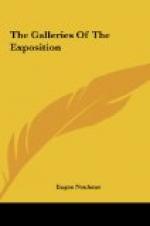Gallery 18.
In the western end of the section presided over by a decorative painting of some aras among orange trees (over the west door), a beautiful, almost classic canvas by Henri Georget commands immediate attention. The poetic idealism of this decorative landscape, together with a fine joyousness, give it unusual character. Alongside of it a very intelligently painted little canvas by Albert Guillaume shows the interior of an art dealer’s shop. The agent is making Herculean efforts to bamboozle an unsuspecting parvenu into buying an example of some very “advanced” painting. The canvas is fine persiflage in its clever psychological characterization of the sleek dealer and the stupid helplessness of the bloated customer and his wife, who seem hypnotized by the wicked eye in the picture. As a piece of modern genre in a much neglected field, it is one of the finest things of recent years. On the extreme left of this wall a very fine bit of painting of an Arabian fairy tale by E. Dinet deserves to be mentioned.
Almost opposite this small canvas Lucien Simon has a large picture painted with the bravura for which he is famous. The atmosphere of this fine interior is simply and spontaneously achieved, and the three figures of mother, nurse and balky baby are excellently drawn. The still-life by Moride, to the left of this picture, shows all the earmarks of the modern school without sacrificing a certain delicacy of handling which is often considered by many modern painters a confession of weakness. A fine Dutch canvas on the extreme left of this wall, by Guillaume-Roger, attracts by a fine decorative note seldom found in pictures of French easel painters.
The east wall of this gallery is distinguished by a number of fine landscapes by different men. Beginning on the left side of the door Jules-Emile Zingg presents two tonally skillful winter landscapes of great fidelity, while on the right is Henry Grosjean’s delicate atmospheric study of a broad valley floor. A decorative watercolour of the Versailles Gardens, by Mlle. Carpentier, commands admiration by reason of its fine composition as well as by the economical but effective technique of putting transparent paint over a charcoal drawing. The sculpture in this gallery is of no great moment. Like much of the modern French sculpture it is very well done in a technical sense without disclosing great concentration of mind.
Gallery 17.
A variety of subjects continues to impress one in this gallery. Portraits, landscapes, and historical subjects, with here and there a genre note, make the general character of the French exhibit, showing at every turn the great technical dexterity for which French art has long been celebrated. There is no picture of outstanding merit in this gallery, unless one would single out a very sympathetic, simple landscape by Paul Buffet and the Lucien Griveau landscape called “The Silver Thread,” diagonally opposite, a canvas of rich tonality and distinctive composition.




